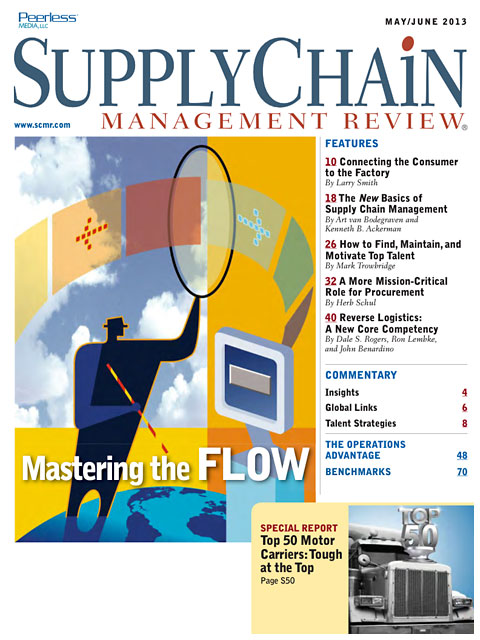Sorry, but your login has failed. Please recheck your login information and resubmit. If your subscription has expired, renew here.
May-June 2013
While supply chain planning based on end-user demand has been applied in the B2B arena for decades, it is only now becoming practical in retail channels. But as distribution resource planning tools and techniques emerge, trading partners can now coordinate their supply chain as if only one company were managing it—effectively connecting the consumer to the factory. Browse this issue archive.Need Help? Contact customer service 847-559-7581 More options
What’s so hard about connecting consumer demand to factory production? How is it that after decades of successful cases demonstrating the value of demand-driven supply chains in business-to-business (B2B) settings, most retailers still lack technologies that can maximize sales at the shelf or Web portal?
There is no single answer to these basic questions. Collaborative planning, forecasting and replenishment (CPFR) techniques have provided clear process roadmaps. Until recently, however, enterprise systems that could support large-scale alignment on a consumer sales-driven demand plan fell far short of the vision. Manufacturers have understood it for decades, but bricks-and-clicks retailers are only now beginning to realize that demand-driven systems and processes are key to defending and growing their share of market—not just against other bricks-and-clicks competitors, but against an explosion of Internet retailers and business-to-customer (B2C) dealers using exchanges such as Ebay and Amazon.
Two factors are galvanizing change. To begin with, customers are raising the bar. Demand-driven systems and processes will help retailers to offer the “omni-channel” service experience that customers are learning to expect from their online and mobile shopping activities. Secondly, recent technical breakthroughs have made possible the deployment of reliable and economically scalable store-level distribution resource planning (DRP) capabilities for retailers. The newest retail DRP systems support detail planning over an extended horizon—a big leap forward in capability over earlier systems, which were purely executional.
 |
This complete article is available to subscribers
only. Click on Log In Now at the top of this article for full access. Or, Start your PLUS+ subscription for instant access. |
Not ready to subscribe, but need this article?
Buy the complete article now. Only $20.00. Instant PDF Download.
Access the complete issue of Supply Chain Management Review magazine featuring
this article including every word, chart and table exactly as it appeared in the magazine.
SC
MR
Sorry, but your login has failed. Please recheck your login information and resubmit. If your subscription has expired, renew here.
May-June 2013
While supply chain planning based on end-user demand has been applied in the B2B arena for decades, it is only now becoming practical in retail channels. But as distribution resource planning tools and techniques… Browse this issue archive. Access your online digital edition. Download a PDF file of the May-June 2013 issue. |
Download Article PDF |
What’s so hard about connecting consumer demand to factory production? How is it that after decades of successful cases demonstrating the value of demand-driven supply chains in business-to-business (B2B) settings, most retailers still lack technologies that can maximize sales at the shelf or Web portal?
There is no single answer to these basic questions. Collaborative planning, forecasting and replenishment (CPFR) techniques have provided clear process roadmaps. Until recently, however, enterprise systems that could support large-scale alignment on a consumer sales-driven demand plan fell far short of the vision. Manufacturers have understood it for decades, but bricks-and-clicks retailers are only now beginning to realize that demand-driven systems and processes are key to defending and growing their share of market—not just against other bricks-and-clicks competitors, but against an explosion of Internet retailers and business-to-customer (B2C) dealers using exchanges such as Ebay and Amazon.
Two factors are galvanizing change. To begin with, customers are raising the bar. Demand-driven systems and processes will help retailers to offer the “omni-channel” service experience that customers are learning to expect from their online and mobile shopping activities. Secondly, recent technical breakthroughs have made possible the deployment of reliable and economically scalable store-level distribution resource planning (DRP) capabilities for retailers. The newest retail DRP systems support detail planning over an extended horizon—a big leap forward in capability over earlier systems, which were purely executional.
 |
SUBSCRIBERS: Click here to download PDF of the full article. |
SC
MR

Latest Supply Chain News
- How CPG brands can deliver on supplier diversity promises
- How S&OP provides the answer to in-demand products
- AI, virtual reality is bringing experiential learning into the modern age
- Humanoid robots’ place in an intralogistics smart robot strategy
- Tips for CIOs to overcome technology talent acquisition troubles
- More News
Latest Podcast

 Explore
Explore
Topics
Latest Supply Chain News
- How CPG brands can deliver on supplier diversity promises
- How S&OP provides the answer to in-demand products
- AI, virtual reality is bringing experiential learning into the modern age
- Humanoid robots’ place in an intralogistics smart robot strategy
- Tips for CIOs to overcome technology talent acquisition troubles
- There is still work to do to achieve supply chain stability
- More latest news
Latest Resources

Subscribe

Supply Chain Management Review delivers the best industry content.

Editors’ Picks





